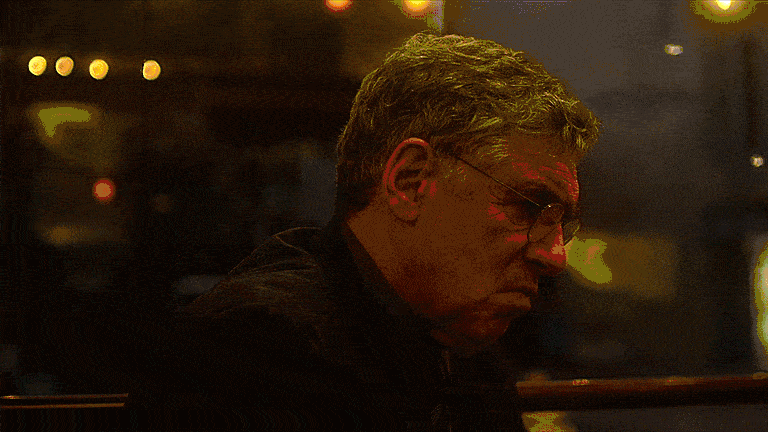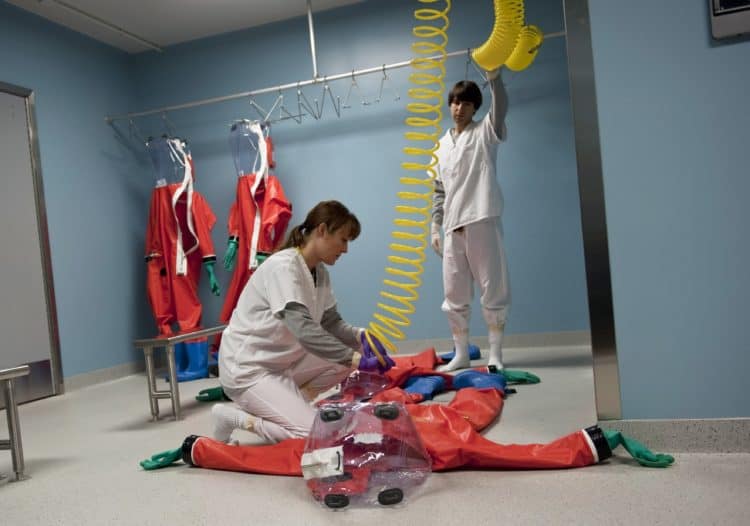Cinematography is a character in Contagion, and an acutely germaphobic one at that.
Midway through Steven Soderbergh’s 2011 medical thriller, someone says, “A virus is too small to be seen on a video camera.” That’s a surprising thing to hear in the middle of a movie that is shot entirely as if you can see the tiny bacteria of the MEV-1 virus wriggling across the skin of its characters. The specter of Contagion’s pathogen haunts every moment of the film; the camera lingers on infected credit cards and subway handrails with such implied meaningfulness that you’d be forgiven for straining your eyes to see if there really is something there.
Even before we know what’s at stake – the lethality of the virus isn’t made clear until a few minutes into the film – director-cinematographer Soderbergh uses an extremely shallow depth of field to communicate this sense of foreboding. The opening scene is set up in such a way that we initially think it’s about one woman’s (Gwyneth Paltrow) infidelity, but before long, the camera’s focus suggestively drops and pulls to glare at the jar of peanuts Paltrow’s rather pallid-looking Beth has just been dipping in to, blurring out everything else. But this is not just another example of pretty bokeh; the shot is full of cold, scientific focus. As if it’s watching a loaded gun, the camera makes more precise movements to first isolate the credit card Beth hands to a waitress; the waitress as she crosses the bar; her fingers as they tap the touchscreen of the cash register; and finally, the card-swipe device.

The sheer precision of the lens’ pinpoint focus hints at only a vague menace in its opening scene, but a grisly sequence four minutes in spells out the threat for us, so that when we next see a protracted close-up of someone’s sweaty face or the door they’ve just pushed open, we understand Contagion’s exacting cinematography as being rightly germaphobic.
What this does – and does very well – is set up suspense. Audiences’ eyes are trained so that, just like someone who is genuinely, pathologically terrified of bacteria, every casual bit of contact made between an infected person and a healthy one registers like the resounding delivery of a death sentence. Soderbergh’s camera doesn’t really have to hone in on the subsequent hugs shared between mother and son, the glasses nonchalantly placed on the bar, or the cell phones passed between friends, but it does so anyway – and just like in those old hygiene infomercials, we imagine for ourselves the tiny, squirming forms of the MEV-1 virus passing from hand to object, its invisible imprint scarring each scene.
But by encouraging audiences to see the homicidal potential in every bit of casual contact, Contagion has presented itself with a problem. Much of the film is concerned with inter- and intra-organisational politics, but it’s difficult for audiences to give the big picture its due attention while our eyes are trained to assess each scene’s risks re: interpersonal contamination. We need something to relieve us of these instinctive concerns: a visual balm that will soothe us enough to allow the story to branch out and move forward. Contagion finds the canny solution it needs by making crucial scenes take place in sterile labs, where characters are safely ensconced in hazmat suits, surgical face masks and latex gloves.
Contagion continues in this germaphobic vein by keeping its characters at arm’s length, as if the camera, too, is susceptible to infection. Whether ill or immune, everyone is treated with the same level of standoffishness: though he is blessedly equipped with the antibodies required to protect him from the virus, the camera keeps audiences away from Matt Damon’s Mitch, shooting him from the other side of a thick pane of glass for caution’s sake. Later, when another character develops a telltale cough, she is shot from several feet away, as if Soderbergh is wary of getting too close. The camera’s subjects – many of which are glimpsed only through windows and TV screens – are almost always shot on their own, below eye-level and from some distance away, denying us the social intimacy of a close-up but also protecting us from contamination.
In alienating its characters in the frame, Contagion’s cinematography replicates the strict protocol of the movie’s isolation wards – which, as the film goes on to show, becomes the established etiquette for every sphere of society, whether private or public. As the overzealous precautions of Damon’s character illustrate, self-quarantining becomes the norm across the film’s world. People sequester themselves in their homes, refraining from friendly or intimate contact lest their affections induce mortal harm. As several scenes and one choppy montage demonstrate, this leads to the breakdown of normal social order: schools close, emergency services strike, trash lines the streets, looting breaks out, and every hive of activity — from mosques and courts to gyms and offices — is emptied of the bustle it usually plays host to.

Contagion projects this vision of a cold, impersonal world while firmly positioning itself within it, but not all of its characters conform in the same way. WHO epidemiologist Leonora Orantes (Marion Cotillard) and CDC doctors Ellis Cheever (Laurence Fishburne) and Ally Hextall (Jennifer Ehle) retain a glimmer of the humanitarian spirit: Dr. Hextall infects herself in order to expedite the discovery of a cure, Cheever donates his vaccine to a young boy, and Orantes renounces her organization after it’s revealed they lied to a vulnerable group of people.
But Contagion doesn’t interpret their heroism in grandiose terms; instead, it’s the little ways they defy their societies’ isolationism that matters. At one point or another, each of these three characters contravenes a fundamental rule in this new world: they touch their fellow man. The sheer uninhibitedness in the way Cheever, Hextall and Orantes abandon the masks and gloves to shake hands, kiss, or stroke the hair of the sick and the unvaccinated is, given the widespread panic and mass media paranoia of the film’s context, extraordinary. But the enormity of their actions is also underscored by their being tacitly juxtaposed against Contagion’s own aloofness. That their affection contrasts so fundamentally with the film’s sterile cinematography only elevates their altruism, framing it as utterly saint-like. Jude Law’s corrupt blogger mocks the idea that Hextall is “Jesus in a lab coat”, but the way her self-sacrifice is shot suggests Soderbergh is implying exactly that.
It’s Hextall’s heroic breakthrough that brings Contagion’s proclivity for isolationist cinematography full circle, too. Just as the film uses tracking close-ups to document the transmission of MEV-1, it uses the same visual punctuation to chronicle its cure – only here, the film’s early pulsing, urgent electronic score is exchanged for one with decidedly more optimistic undertones. Paired in this way, when the camera’s lingering eye regards the syringes, it does so with a kind of holy reverence: how can something so small do so much good? Contagion is, of course, based on the inverse being true — and by shooting both catastrophe and miracle in the same way, it reminds us that the two share much of their DNA.
The post The Infectious Cinematography of ‘Contagion’ appeared first on Film School Rejects.
No comments:
Post a Comment